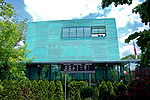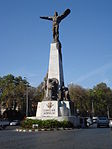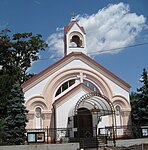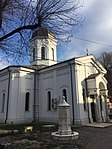Social Democratic Party (Romania)
The Social Democratic Party (Romanian: Partidul Social Democrat, PSD) is the largest social democratic political party in Romania and also the largest overall political party in the country, except for European Parliament level, where it is the second largest by total number of MEPs, after the National Liberal Party (PNL). It was founded by Ion Iliescu, Romania's first democratically elected president at the 1990 Romanian general election.The PSD traces its origins to the Democratic National Salvation Front (FDSN), a breakaway group established in 1992 from the post-communist National Salvation Front (FSN). In 1993, this merged with three other parties to become the Party of Social Democracy in Romania (Romanian: Partidul Democrației Sociale in România, PDSR). The present name was adopted after a merger with the smaller Romanian Social Democratic Party (PSDR) in 2001. Since its formation, it has always been one of the two dominant parties of the country. The PDSR governed Romania from 1992 to 1996, while the PSDR was a junior coalition partner between 1996 and 2000. The merged PSD was the senior party in the coalitions governing from 2000 to 2004, and from March 2014 to November 2015, as well as one of the main coalition partners between December 2008 and October 2009 (with the Democratic Liberal Party, PDL) and again between May 2012 and March 2014 (as part of the Social Liberal Union, USL). It is a member of the Progressive Alliance (PA), which was founded in 2013, Socialist International (SI), and Party of European Socialists (PES). As of 2014, the PSD had 509,000 members.The PSD left government after former Prime Minister Victor Ponta resigned in November 2015, only to return as the senior governing party in January 2017, shortly after it achieved a major victory in the 2016 Romanian legislative election. Party founder Iliescu became the president of Romania, in office from the 1989 to 1996, and again from 2000 to 2004. The largest party in the Parliament of Romania with initially 47 seats in the Senate of Romania and 110 seats in the Chamber of Deputies (as obtained at the 2020 Romanian legislative election), it also has the largest number of mayors, as well as the second largest number of local and county councillors and county presidents (after PNL), remaining the biggest and most influential political force in the country to the present day.
Excerpt from the Wikipedia article Social Democratic Party (Romania) (License: CC BY-SA 3.0, Authors).Social Democratic Party (Romania)
Șoseaua Pavel Dimitrievici Kiseleff, Bucharest Aviatorilor (Sector 1)
Geographical coordinates (GPS) Address Nearby Places Show on map
Geographical coordinates (GPS)
| Latitude | Longitude |
|---|---|
| N 44.461238888889 ° | E 26.081347222222 ° |
Address
Șoseaua Pavel Dimitrievici Kiseleff 10
011346 Bucharest, Aviatorilor (Sector 1)
Romania
Open on Google Maps











